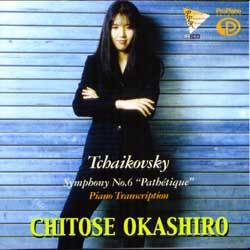|
PPR number: PPR224530

|
New York Times
on The Web
By IRA ROSENBLUM
(November 10, 2000)
Familiar Works in New Clothes
Have you ever experienced running into someone you know
-- a friend, a colleague, even a family member -- and finding
they look unfamiliar somehow? Perhaps they've changed their
hair color, grown or shaved off a beard, lost some weight,
and suddenly you barely recognize them. Outer appearances
make for powerful associations, even in music. Sometimes a
new arrangement, a transcription, even a simple alteration,
can reveal something new or unexpected. Here are six disks
of very familiar works cloaked in new clothes
|
Tchaikovsky: Symphony No. 6 ("Path?tique"), transcribed
for solo piano
Chitose Okashiro, Pianist
Pro Piano PPR 224530
Before the existence of phonographs and radios, piano transcriptions
of orchestral works provided a way for the public to become acquainted
with symphonies. Many composers took up the cause (Liszt's arrangements
of Beethoven's nine crop up on recital programs from time to time).
Even after the stereo replaced the piano as the musical instrument
of choice in most homes, composers and performers, perhaps challenged
by the difficulties inherent in making and playing transcriptions,
continued the practice.
One such arrangement, of Tchaikovsky's popular "Path?tique" Symphony,
was made in the 1920's by Walter Niemann. Few symphonies are intrinsically
suited for keyboard reduction -- after all, it is the myriad colors
and timbres of the orchestra that give them their character -- and
Tchaikovsky's Sixth seems one of the least likely to succeed. To wit,
how can a piano emulate this symphony's extraordinary opening, the
gloomy wail of a solo bassoon rising over a cluster of double basses?
Yet, as Chitose Okashiro aptly proves, in the right hands, Mr. Niemann's
arrangement is as thrilling as the original.
Miss Okashiro must be enthralled with transcription as a form, having
already recorded various composers' piano arrangements of excerpts
from three Wagner operas in "Richard Wagner Piano Transcriptions."
As on that disk, her playing here is astonishing. With such a variety
of texture and color, and so many notes flying by, it's hard to believe
that she doesn't have an extra hand or two. The opening movement's
well-known, tender second theme sings as soulfully as a full contingent
of strings. The frenetic development section, with its tremolos and
thundering octaves, is surprisingly pianistic, sounding right out
of Liszt's "Dante" Sonata. The scherzo-like third movement is a tour
de force, its cascading double notes whirling by with incredible precision.
Undoubtedly you don't need this CD to become familiar with Tchaikovsky's
last symphony, but if you want to be wowed by some staggering piano
playing, have a listen.
|
|